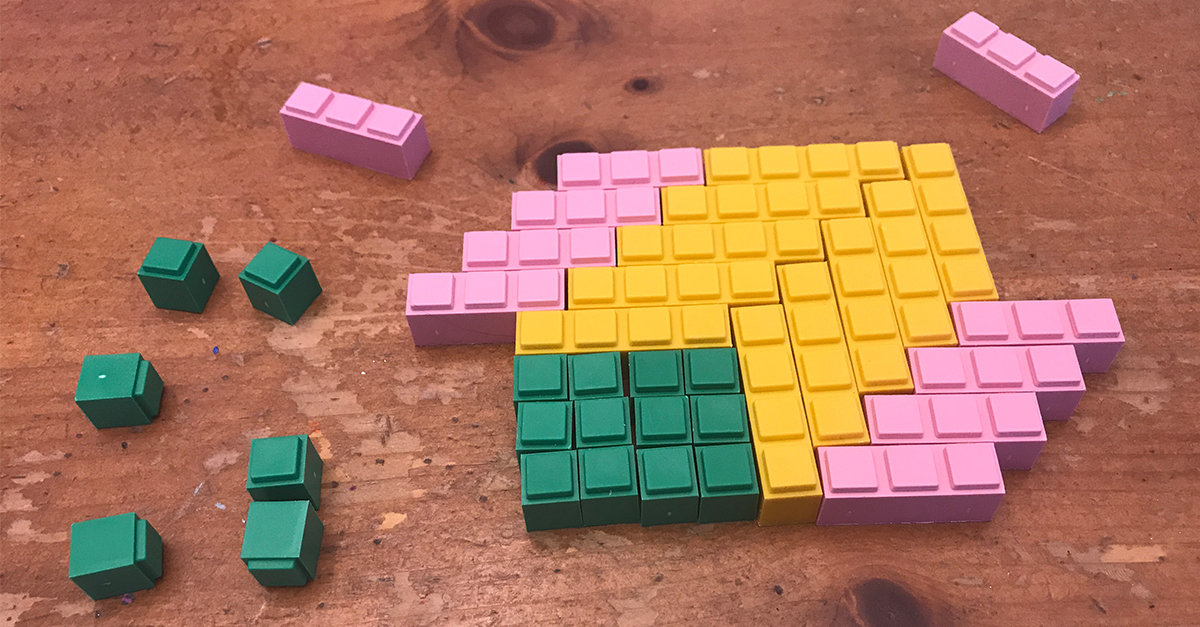Integer Blocks = Success for the Artsy Math Student

The misconception that students are either strong in math or strong in art but not both is something I hear often. As a Placement Specialist, I often find struggling math students do gravitate to the artsy side. So how do we help these struggling math students succeed?
As I collaborate with a parent/instructor, the initial answer has more to do with changing the approach and mindset. The ultimate avenue for success is to reveal both math and art are used to describe concrete objects, tell a story, or reveal a vision. The integer blocks are an effective tool to enhance the student’s ability to make this connection and thrive in both subjects.
Why Math Manipulatives?
Young artists have a rich supply of images in their long-term visual memory. These images are stored and built upon. They pull from these treasures as they create and communicate through their art. Long-term visual references have shape, color, angle, texture, and line. They increase and evolve. Resources are continually assessed while the students are creating. Math-U-See Integer Blocks have a consistent shape, texture, and color, providing a concrete visual to represent the numbers. This, along with the Build-Write-Say steps, provides the learner with resources to store in their long-term memory. When used along with these strategies, they are able to access these mental images making visual sense of the abstract math facts and concepts.
Teaching Back
Once the student shows an understanding of the new concept, it is important that the student teaches you the concept using the blocks before moving on. Motivate the student to advocate for themselves as they decide what they need to successfully prepare to teach.
For example, they might find it helpful to have a magnetic whiteboard and attach ½” magnetic strips to a few of the blocks. This would allow them to teach in a similar manner to what they see in the videos. I often find young artists love to educate others as to their process whether it is art or math.
When we prepare to teach something we more intentionally store that information in long-term memory. Requiring that your student is not allowed to move to the next lesson without teaching will be a motivator for using the blocks and provide an opportunity to share and further develop their love of teaching.
As a teaching artist, I find this a valuable method for my own learning. There are times I need extra motivation to learn something I don’t yet know. If I schedule a class using the concept, by the time my students show up, I have developed the skill I might otherwise find difficult.
Word Problems and Math Manipulatives
When reading the following word problem, what do you see in your head?
“Sally had 5 apples. She found 3 more. How many apples does Sally now have?”
You might say that you see 5+3=8. You might see 5 apples lined up and then 3 more and you count the apples. (Post what you see in the comments so we can all learn from each other.)
Here is what the artist in me sees:
It’s a sunny day. Sally is standing in a grassy orchard. She has red curly hair and is holding a woven basket to carry apples.
When I say this to parents whose artist student struggles with word problems they often laugh and say, “Yes, that’s about right.” Or they are shocked and say, “I had no idea that might be happening.”
For the “artsy” student, word problems can get cluttered when they visualize the scene instead of the numbers or concepts needed for the solution. If you are using the Math-U-See Curriculum, the word problems on the practice pages are intentionally designed to work with the manipulatives. Encourage the student to choose one of the word problems for “teaching back”. Using the manipulatives in this way will provide them with a way to remove the clutter.
Creative Processing
Active artists are processors. When your artist is starting to develop the next skill they practice, ponder, discover and marinate. They rarely “get” and apply their next skillset instantly. Often, the creative processor will not instantly “get” a new math concept either. It is not a matter of intellect, it is a matter of how they process new concepts.
Growing up, I survived basic math but it was indicated I would not be able to move on to upper levels. Later, when I was challenged to complete Math-U-See Algebra 1 as part of my job, a major switch happened. I realized when I applied those same processing skills I embrace in art learning to math, it was a game-changer. Math not only became enjoyable and successful, but I also was able to see that math and artwork in tandem. I truly believe the combination of solid art and math skills will be highly valued in future job markets. Math-U-See Integer Blocks, when used as directed, have the potential to reveal the art connection for your student.
For more information on how math and art connect, read my blog post titled “The Connection Between Math & Art”.
We Are Here to Help
If you have questions about teaching math, we are here to help!
Get in Touch